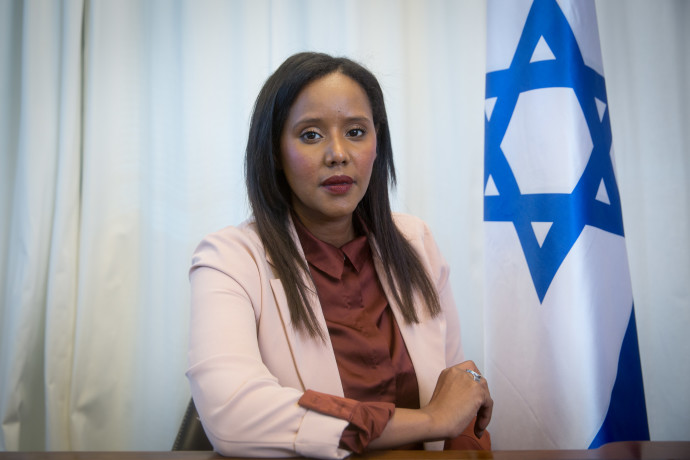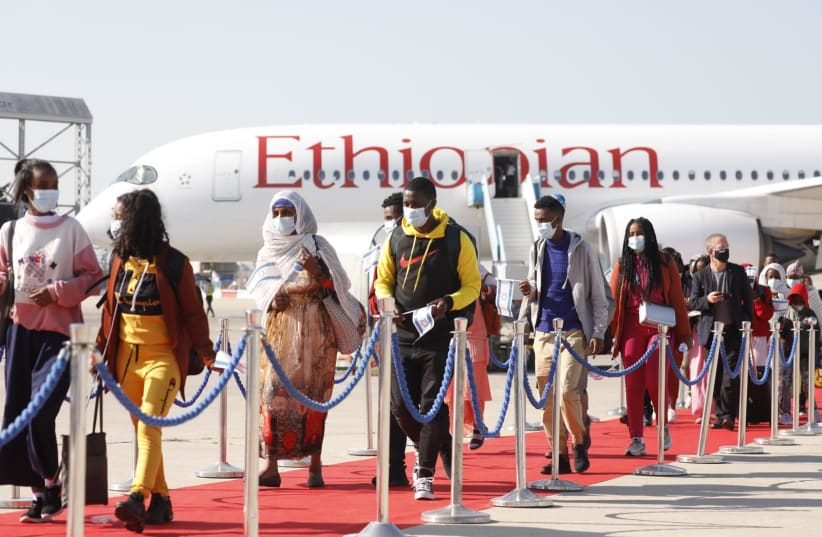Israel absorbed 60,000 new olim over the past Jewish year and expects to see the total reach 65,000 by the end of 5782, a 128% increase compared with 2021, when 28,500 Jews immigrated to Israel.
The country from where the most immigrants came over the past year was Russia with 47%. That was followed by Ukraine at 25%, the US 6%, France 4%, and Ethiopia 2%. Some 12% arrived from other countries.
Operation “Olim Return Home,” the drive to absorb immigrants from the countries directly affected by the Russian-Ukraine war, saw 39,214 immigrants arrive since February, including 11,191 from Russia and 7,513 from Ukraine. An additional 19,774 immigrants have not yet settled their status.
At a news conference on Monday ahead of Rosh Hashanah, Aliyah and Integration Minister Pnina Tamano-Shata thanked organizations such as the Jewish Federations of North America, Keren Hayesod and others for assisting with funding the operation.
“World Jewry put close to $100 million into this operation,” she said. “We saw Jewish mobilization in its glory, and it helped in our ability to invest budgets in absorption, while they invested in rescue.”
“World Jewry put close to $100 million into this operation, we saw Jewish mobilization in its glory, and it helped in our ability to invest budgets in absorption, while they invested in rescue.”
Aliyah and Integration Minister Pnina Tamano-Shata

Tamano-Shata noted that the organizations reached out beyond just the Jewish community, and how “they did not only save those who are entitled to immigrate to Israel through the Right of Return law but anyone who needed help.”
According to a report released by the ministry, the city that absorbed the largest number of olim in 5782 was Tel Aviv, with 6,327 immigrants, followed by Haifa with 6,182, Netanya with 6,069, and Jerusalem with 4,285.The minister said that Israel had absorbed 323,000 immigrants over the past decade.
“There is a change of consciousness in Israeli society,” the minister said. “Once Israelis thought that the Aliyah Ministry was sort of a ‘stepchild,’ an unimportant ministry,” and that immigrants were not well treated. She noted how when she made aliyah at age three from Ethiopia, “I suffered from discrimination growing up.”
Helping Ethiopian Jews make aliyah
The minister said she was disappointed that she has only been able to assist a few hundred of the Jews who live in the Tigray region that is at war with the Ethiopian government.
“There are close to 300 Tigray Jews who are eligible to make aliyah according to the Law of Return. Has anyone lifted a finger to bring them to Israel?”
She noted how “I have brought 5,000 Ethiopians to Israel in the past two years, all of whom are first-degree relatives of Israelis,” but that there are 2,000 more immigrants to come in Ethiopia who are first-degree relatives of Israeli citizens, and others who are more distant such as grandparents or grandchildren of Israelis.
Tamano-Shata disclosed that she intended to create a position as a project manager for the issue of aliyah from Ethiopia, since there are many “misunderstandings” on how many Jews still live in the country, and how they have been determined to be Jews.
“I have asked [former education minister] Rabbi Shai Piron to lead a mission of heads of the Jewish Ethiopian community in Israel to Ethiopia in order to learn about this topic, and to finalize exactly how the government should deal with this issue.”
She blamed Interior Minister Ayelet Shaked, without mentioning her by name, for not approving Piron as a project manager. Piron was a member of the Yesh Atid Party when Tamano-Shata was also a member of that party. The two have since left Yesh Atid.
Tamano-shata admonished the government for how it had managed aliyah from Ethiopia. “The State of Israel allowed private entities to record data according to which the government decided who was eligible to make aliyah. The Interior Ministry relies on private lists. That’s why I asked for a project manager.”
Operation Tzur Yisrael
Under Operation Tzur Yisrael, 1,458 Ethiopians have made aliyah so far in 2022, and the ministry expects to double that number by the end of the year.
She also said there has been a “serious exploitation of Ethiopian Jews, especially the new immigrants, [who] do not speak the language, do not receive services they should receive, do not have an address, and aren’t able to respond.”
Tamano-Shata also criticized former prime minister Benjamin Netanyahu, saying he had “made decisions [regarding aliyah from Ethiopia] without giving them a budget.”
She added that “even with [Naftali] Bennett it was not easy. I told him that I would dismantle the government [if I would not receive a budget for aliyah], and I meant every word of it.”
Tamano-Shata also chastised/admonished Sderot Mayor Alon Davidi, whom she accused of “not wanting a merkaz klita [absorption center] for Ethiopian Jews in his city. That is pure racism. What is amazing is that he is a member of the board of trustees of the Jewish Agency. This is racism. It is very sad, and this is not the face of Sderot. That you are surrounded by Gaza does not allow you to be a racist.”
In response, the Sderot Municipality said, “Regarding the building in question, the developer received a permit to build sheltered housing, and the planning designation of the place does not allow it to be turned into an absorption center. Any other claim made here is tantamount to libel.”
The municipality added, “It is important to note that at the beginning of the year, together with Minister Tamano-Shata, we opened a cultural center for Ethiopian expats with the municipality’s funds.”
The Sderot municipality concluded that “despite the serious allegations that the minister hurled at the Sderot Municipality and its leader, we will continue to cooperate with the ministry, the government, and do good for the thousands of immigrants who have come to the city in recent years, and will continue to come to it. We urge Tamano-Shata to do her politics on the eve of the election elsewhere.”
The municipality also said it “has always been a city that absorbs immigrants, and will continue to host immigrants in the coming years as well. We are proud of our many residents who came from the Caucasus countries, Bukhara, Ethiopia, the Bnei Menashe community from northern India, and other communities. In the last year we took in refugees who immigrated to us from Ukraine.”
